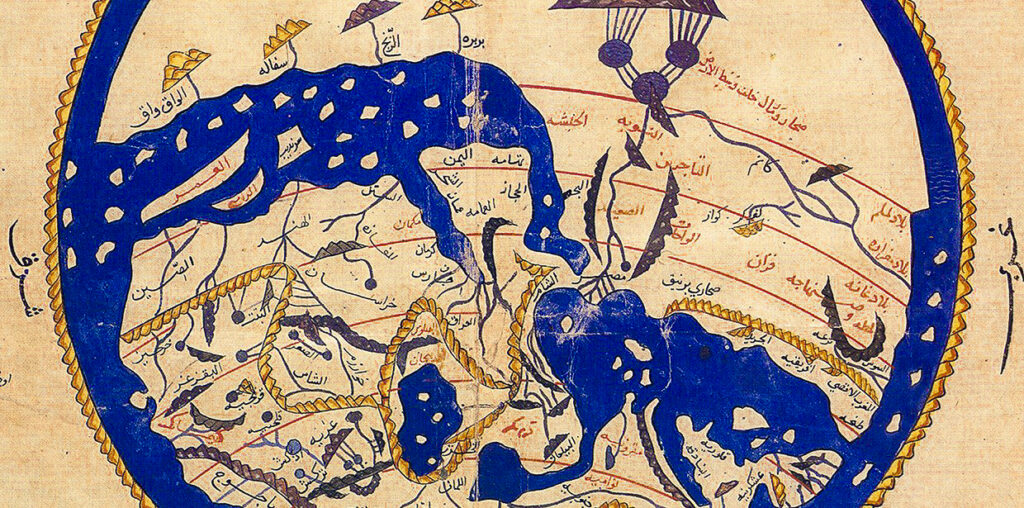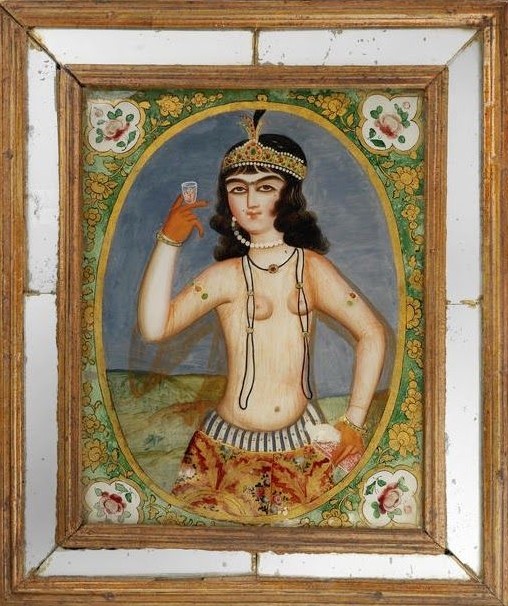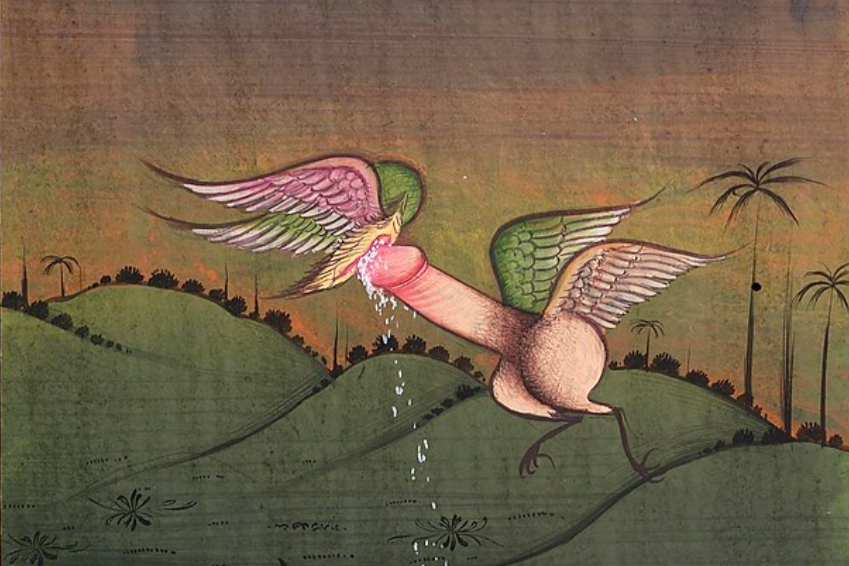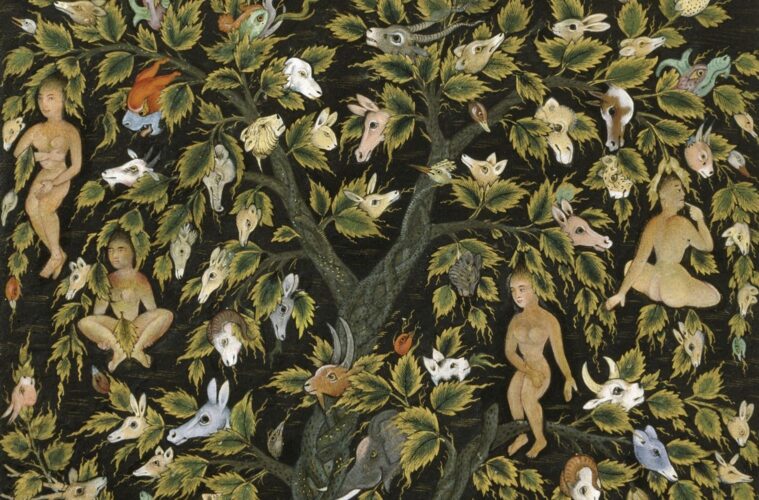عربي
Words by: Rana Tawil
Images from various manuscripts
This article is part of the “The Wawa Complex” issue
The mythical island of Waqwaq fascinates me to no end. The first time I came across this island, I was looking at medieval Arab maps, trying to learn about alternative renderings of information and geography. Its name was a little inscription in the North East corner of the map. I had just assumed it to be an ancient name of a contemporary city.
Months later, I learned that the island of Waqwaq was actually an allegory for a paradise, an untouched earth, that was the home of Ibn Tufail’s protagonist in his philosophical tale, Hayy ibn Yaqzan (circa 1160 CE). The central character learns about the cycles of life through the flora and fauna of the island and infers eternity and divinity through mere observation, showing that one proves God’s existence through deduction rather than religious texts or societal teachings.
My third, unexpected encounter with the island – and the most life-changing –was through Wallada bint al-Mustakfi’s (1001–1091CE) poetry. On first glance, the verses seem to have nothing to do with the island of Waqwaq.
إنّ ابـن زيـدون له فـقـحة تـعـشـقُ قـضـبـان السراويلِ
لَو أبصرت أيراً على نخلة صارَت منَ الطيرِ الأبابيلِ
Because of his love for the rods in the trousers, Ibn Zaydun,
In spite of his excellence,
If he would see a penis in a palm tree,
He would fly after it like a craven bird.1
These verses were part of an invective poem conceived in response to an ex-lover, poet Ibn Zaydun’s, slander after their relationship had soured, when he publicly denounced her sexual experience and experimentation. Wallada and Ibn Zaydun’s relationship was anything but conventional from the start: Wallada was polyamorous and queer, and Ibn Zaydun moved on from their relationship by “rebounding” with men. In her response, Wallada calls out Ibn Zaydun’s own queerness, making reference to Surat Al-Fil from the Quran in which an enemy army was attacked by a God-sent flock of ravaging birds, and compares his appetite for other men to the birds’ singular focus on their enemy.
Wallada’s “penis in a palm tree” reference however, is the covert link back to the island of Waqwaq. As I researched to learn more about the context of these verses, I discovered that the prevalent narratives about al-Waqwaq revolve around its most “rewarding” species: a tree that bears naked women as fruit, hanging from their hair. They were said to possess unimaginably beautiful faces, scents, bodies, eyes, hands, feet, hair, breasts, posteriors, and vulvas, which also provide far more pleasure for men than those of average women. It was also believed that, after cutting these women-fruit’s hair and severing them from the tree that bears them, the women would scream waq waq waq until their death in a day or two, and that whoever cut them loose could have sexual intercourse with them until that time.

World map by the Moroccan cartographer Al-Idrisi
Eventually, the island became so canonically accepted that it began to appear on physical maps as a real place that men could aspire to arrive at one day, named after the sound of the women-fruit’s suffering.
إن الله قد وسمني بجمال أحببت أن يراه الناس فما كنت لاستره
Allah, who is blessed and exalted, marked me with beautiful features that I like to show people so that they may know virtue with respect to them. So I will not take the veil for by Allah there is no blemish in me that anyone can think of.
– Aisha bint Talha (عائشة بنت طلحة)2
Most Medieval Arabian societies (700 – 1800 CE) prohibited men and women socializing together. Medieval Arabian societies were often governed by religious rulers, whose power was in their sacred reign and political economic prowess. They determined what was and was not accepted in the eyes of God, and their word would go uncontested due to their regard as holy rulers. What mere mortal would possess the right to counter their, or God’s, word?
However, as is the case today, the nature of these societal expectations varied greatly depending on social strata. Upper class women had the wealth and power to live more freely and out of reach of society’s judgment and censorship, due to their proximity to the divine ruler. In contrast, women of lower classes did not have the privilege to not socialize with the men of their era due to their need for work. This was the case whether they were working as merchants, farmers, or qiyan (pl., sing. qayainah), a group of women who were part of rulers’ courts, but were in fact enslaved (owned, bought, and sold as assets). Qiyan’s status as owned denied them basic rights, such as owning property and the right to legal action, which free, upper and middle-class women were entitled to. Therefore, it was essentially only middle-class women who were restricted to their homes in order to fulfill their religious duty of not consorting with men in protection of their virtue and dedication to their piety. So, in this context, (upper) middle-class men and women often engaged in same-sex premarital relations — they could only consort with the same sex before marriage, and forgoing all sexual relations before marriage was as far-fetched then as it is now.

Portrait of a Persian woman from the Qajar period
It is mind-boggling to discover what the collective imagination of different cultures is capable of fabricating. More disturbing, however, are the women-bearing trees of the Waqwaq island. In this fantasy, women are rendered incapable of accomplishing much more than providing non-consensual pleasure before dying. This reverie reduces their existence to temporary sex objects that came without the societal complications and taboos that real women dragged along. It’s not a very heartening, let alone respectful, depiction of women, then or now.
Compared to its original conception as an island where one finds God, this version of Waqwaq as a hedonistic island for male satisfaction makes little sense. It makes even less sense when you realize that women’s cultural production between the years 700–1800 CE was rich with agency and assertion. Although most information about that time period is relatively obscure, it is striking that such misogynistic representations of women are still easier to research than the poetry of remarkable cultural instigators from that era – Wallada, Safiya al-Baghdadiya, Hind bint al-Nu’man, Hafsa ar-Rukuniyya, and so many more – who tackled everything from polyamory and body image to all-consuming, posthumous love.
أنا فتنة الدنيا التي فتنت حجا كل القلوب فكلها في مغرمِ
أترى محياي البديع جماله وتظن يا هذا بأنك تسلمِ
I am the wonder of the world, ravisher of hearts.
Once you have seen my stunning looks, you are a fallen man.
-Safiya al-Baghdadiya (صفية البغدادية)3
On a more positive note, the widespread acceptance of this island as a real entity is testament to how pervasive sexual discourses were in daily, medieval Arab life. However, the gap between that openness of the past and contemporary conservatism around these topics forces us to reckon with the efficacy of colonialism and the patriarchy in drowning out women’s voices from history, and the additional step of manipulating us to believe that the only place for our female ancestors in society was as an object of male desire.
The colonial project’s annihilation of cultures and traditions in the SWANA region is perhaps particularly palpable when it comes to sexuality; the Arabic language continues to exhibit an alarming dissonance and difficulty when it comes to discussing one of the most natural parts of life. Today, words about sexuality in Arabic are derived from their English-language equivalents rather than the region’s centuries-long sexual history. For instance, the Arabic words for homosexuality and heterosexuality are al-mithliyah and al-ghayriyah, respectively, which are literal translations of only the prefixes homo and hetero but have no link to sexuality whatsoever.4
These subpar translations are sinisterly inadequate when people are expected to use them to represent themselves, find solace, and build connections with others. Bareed Mista3jil (2009), a collection of real-life accounts from Lebanese lesbian, bisexual, queer, and questioning women and transgender people, delves into this inadequacy poignantly in its introduction. In spite of the book’s Arabic title and colloquial anecdotes, the preface explains that this book was written in English because all of its contributors could not identify with the Arabic words for “lesbian” or “queer.” They could not feel comfortable nor represented within their own language. In order to rectify this linguistic gap, there have been ample efforts to coin new terminologies that accurately describe people’s sexual preferences in recent years. Rather than starting from scratch, or modeling Arabic words after other languages, there are also attempts to resuscitate words from the SWANA region’s rich sexual history as they are more culturally rooted and untainted with colonial undertones. While these efforts are starting to make headway, they have yet to be socially accepted and pervasive in the SWANA region’s colloquial diction at the time of writing.

A flying penis copulating with a flying vulva
Our sexual illiteracy can be traced back to yet another detrimental, colonial imposition: the notion of sexual identities rather than sexual practices, which were the norm throughout the region’s history. The distinction comes from the 20th century “revelation” of Western psychiatry that a person’s sexual preferences are an intrinsic part of their identity, that it impacts who they are in every aspect of their lives and is an enduring part of them. This ideology was forced onto people of the SWANA region, whose long-standing legacy was that of sexuality fluidity. There were no Arabic words for homosexuality, bisexuality, or heterosexuality because they were not notions that existed, seeing as these terms refer to identities rather than practices.5 There are, however, a plethora of words throughout various Islamic Empires that describe and categorize every conceivable sexual practice under the sun, as hyper-categorization is an integral part of the region’s culture, which enabled different topics to be critically discussed, as can be seen in the region’s literary output when it comes to food, philosophy, religion, science, medicine, astronomy, and more.
Though we are not blameless for where we are today, it is implausible and impossible to separate the current state of sexuality in the SWANA region from the legacies of colonialism. The gems that have survived from medieval Arabia, in spite of efforts to eliminate them, paint a vivid picture of women’s roles and pleasures in varied and nuanced ways, offering some sort of redemption. In spite of male fantasies co-opting the voices of women and other marginalized groups, I still find my recurrent encounters with the Island of Waqwaq to have been strangely serendipitous, as it was my gateway to a world where women could (sometimes) speak and act freely without fear, condemnation, or retribution.
The intentional and consistent omission of these women, their contributions, and their desires from canonical history, at the hands of both patriarchal and colonialist systems, discredits the fact that they were nonetheless a product of their social milieu. They existed in the way they did as a result of their environment and context. Whether they were reactionary, revolutionary, or representative of their time, they existed, they endured, and they expressed themselves assertively. This should justify their canonical position in our versions of history, or at least make them deserving of more space than the women-fruit of the Waqwaq island. At the end of the day, considering how men have done their best to eliminate the real voices of their powerful women contemporaries, are we really going to believe or even celebrate the same men’s reduction of the Waqwaq women to noisemakers and sexual objects?
- English translation from Marla Segol, “Representing the Body in Poems by Medieval Muslim Women,” MFF 45 (1), 2009: 161
- English translation from Segol 2009: 160.
- English translation from Segol’s 2009: 153.
- Sahar Amer, “Medieval Arab Lesbians and Lesbian-Like Women,” Journal of the History of Sexuality 18(2), 2009: 224.
- Ibid

